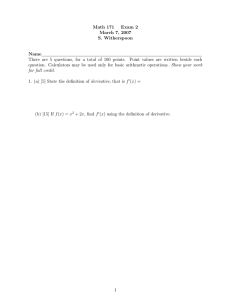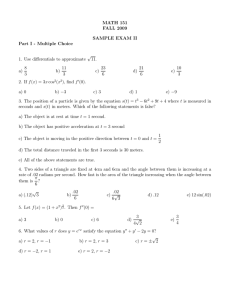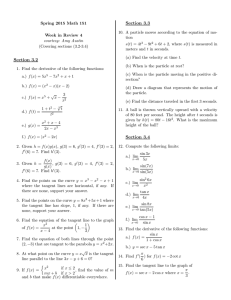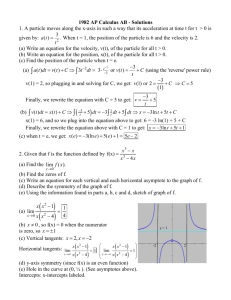MATH 151 Spring 2015 SAMPLE EXAM II
advertisement
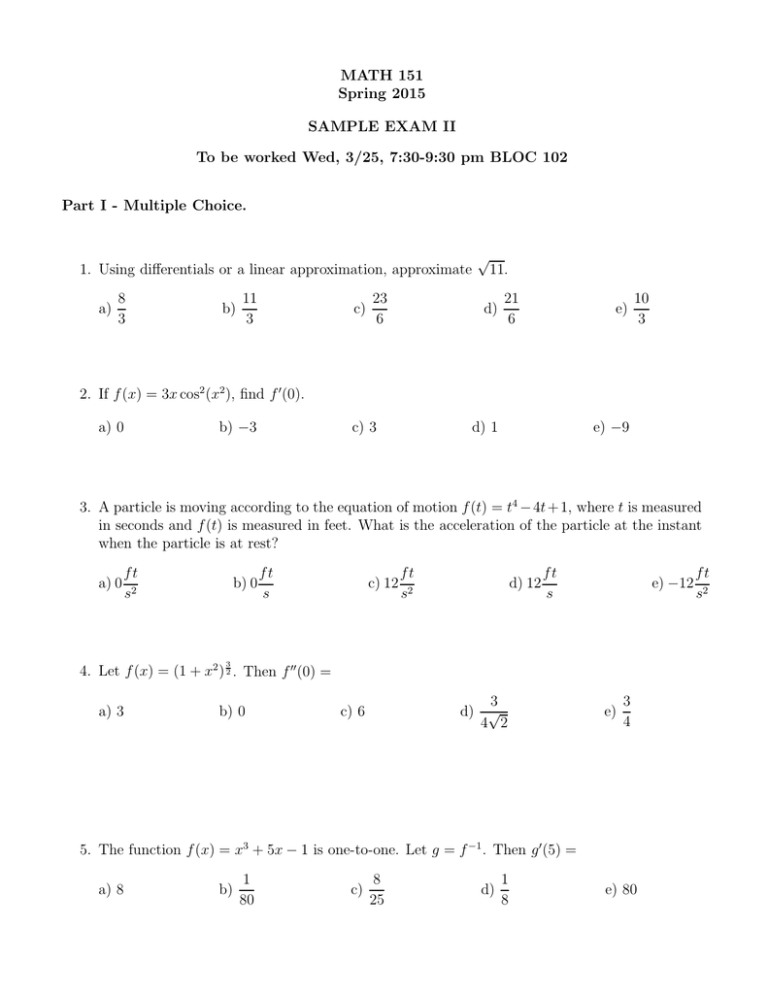
MATH 151 Spring 2015 SAMPLE EXAM II To be worked Wed, 3/25, 7:30-9:30 pm BLOC 102 Part I - Multiple Choice. 1. Using differentials or a linear approximation, approximate a) 8 3 b) 11 3 c) 23 6 √ 11. d) 21 6 e) 10 3 2. If f (x) = 3x cos2 (x2 ), find f ′ (0). a) 0 b) −3 c) 3 d) 1 e) −9 3. A particle is moving according to the equation of motion f (t) = t4 − 4t + 1, where t is measured in seconds and f (t) is measured in feet. What is the acceleration of the particle at the instant when the particle is at rest? a) 0 ft s2 b) 0 ft s c) 12 ft s2 d) 12 ft s e) −12 3 4. Let f (x) = (1 + x2 ) 2 . Then f ′′ (0) = a) 3 b) 0 3 d) √ 4 2 c) 6 e) 3 4 5. The function f (x) = x3 + 5x − 1 is one-to-one. Let g = f −1 . Then g ′ (5) = a) 8 b) 1 80 c) 8 25 d) 1 8 e) 80 ft s2 6. Given the curve parametrized by x = t3 − 3t2 − 9t + 1, y = t3 + 3t2 − 9t + 1, at which point does the curve have a vertical tangent? a) (1, −3) b) (6, 12) d) (−1, 3) e) (1, 1) c) (−10, 6) 4 cos x − 4 + 3 sin x = x→0 5x 7. lim a) 4 5 b) − 4 5 c) 3 5 d) 1 e) 0 8. Find the slope of the line tangent to the curve given by y 2 + xy = 8 at the point (−2, −2). a) −2 b) − 10 3 c) − 1 3 d) −3 e) 0 9. lim+ ex/(5−x) = x→5 a) 0 b) ∞ c) −∞ d) 1 e) e 10. Let f (x) be a differentiable function and let g(x) = 3x2 − 1. Let H(x) = f (g(x)), the composit of f and g. If f (0) = 1, f ′ (0) = −1, f (1) = 3, f ′ (1) = 2, f (2) = −1, f ′ (2) = 5, find H ′ (1). a) 30 b) 12 c) −6 d) 6 e) 5 c) −∞ d) 1 e) 3 11. lim 31−x = x→∞ a) 0 b) ∞ 12. Find the domain of vector function r(t) = √ t t−2 . , t2 − 16 a) (−∞, −4) ∪ (−4, 2) ∪ (2, 4) ∪ (4, ∞) b) (−∞, −4) ∪ (4, ∞) c) (−∞, −4) ∪ (−4, 2] ∪ [2, 4) ∪ (4, ∞) d) [2, 4) ∪ (4, ∞) e) (2, 4) ∪ (4, ∞) 13. If r(t) = hcos 3t, ti is the position of an object at time t, find the acceleration of the object at π time t = . 9 a) 1 ,0 2 1 b) − , 0 2 9 c) − , 0 2 d) 9 ,0 2 e) h3, 0i 14. If f (x) = ex tan x , find f ′ (x). a) f ′ (x) = ex tan x b) f ′ (x) = sec2 xex tan x c) f ′ (x) = (tan x + x sec2 x)ex tan x d) f ′ (x) = (tan x + x sec x tan x)ex tan x e) f ′ (x) = x tan xex tan x−1 15. Find the equation of the tangent line to the graph of x = e2t , y = tet at the point (1, 0). a) y = 2x − 1 b) y = 4x − 4 1 1 c) y = x − 2 2 1 1 d) y = x − 3 3 e) y = x − 1 16. Find the quadratic approximation for f (x) = a) x2 − 3x + 3 b) x2 − x + 2 c) x2 − 2x + 1 d) x2 + 4x + 5 e) x2 + x − 3 1 at x = 1. x Part II - Work Out 17. The position of a particle at time t is given by r(t) = speed of the particle when t = 0. 18. f (x) = bx2 − 2ax + 5 if x ≤ 2 ax − 6 cos t sin t , t . Find the velocity and et e , if x > 2 a.) What must be true for f (x) to be continuous everywhere? b.) Find the values of a and b that make f (x) differentiable everywhere, if possible. If not possible, explain why. 19. A trough is 20 feet long. The end of the trough is an isosceles triangle with height 10 feet and length of 3 feet across the top. If water is poured in the trough at a rate of 3 cubic feet per minute, how fast is the water level rising when the height of the water is 1 foot? 20. Given the equation 2exy = x + y, find dy when x = 0 and y = 2. dx 21. Sketch the graph of f (x) = x2 + x and show there are two tangent lines to the graph of f (x) that pass through the point (2, −3). Find an equation of these tangent lines. 22. A camera is positioned 4000 feet from the base of a rocket launching pad. At a particular moment, the rocket rises vertically and its speed is 600 ft/s when it has risen 3000 ft. a) How fast is the distance from the camera to the rocket changing at that moment? b) If the camera is focused on the rocket, how fast is the camera’s angle of elevation changing at that moment?
